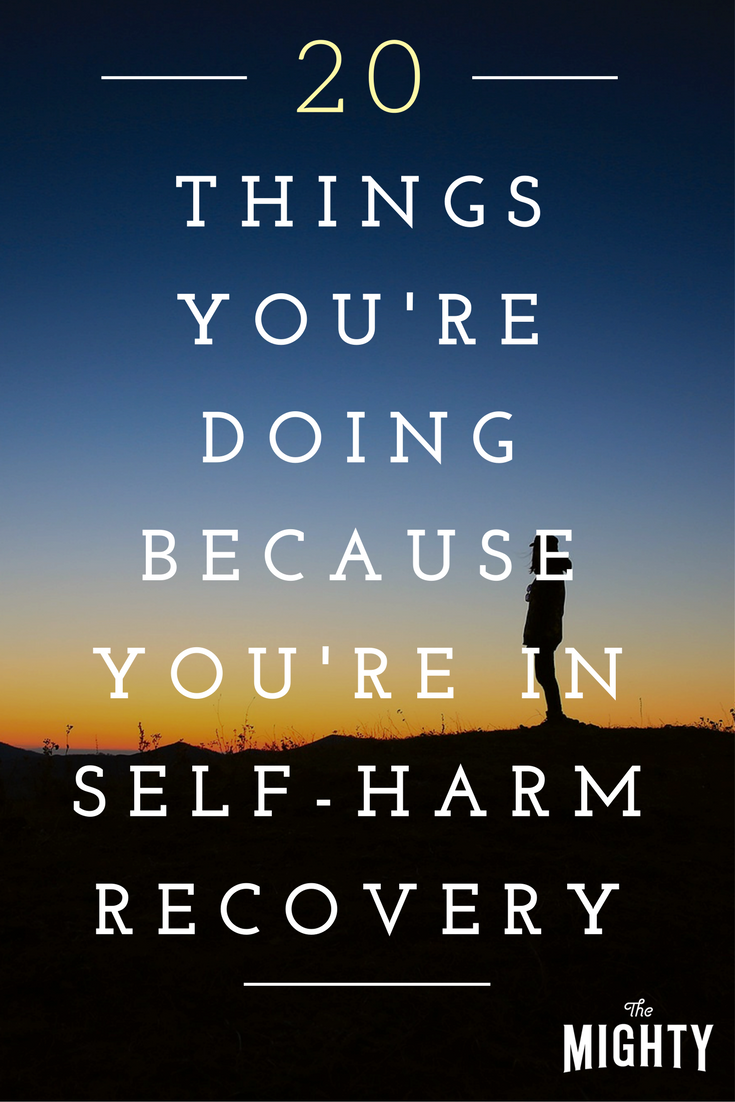Editor’s note: If you struggle with self-harm, the following post could be potentially triggering. You can contact the Crisis Text Line by texting “START” to 741-741. For a list of ways to cope with self-harm urges, click here.
Self-harm is typically largely misunderstood and stigmatized — many who self-injure may feel the need to hide the behavior or the scars left behind. But even when you’re in recovery, the urges don’t always just “go away,” and some might still feel the need to hide the coping strategies they use to manage the urges they experience now.
We wanted to know what recovery from this typically hidden practice really looks like, so we asked people in our community who’ve engaged in self-harm to share with us one thing they do because they are in self-harm recovery. If you or a loved one self-harms, please know you’re not alone and help is available.
Here’s what they shared with us:
1. “I haven’t self-harmed in two and a half years. When I have a strong urge, I ask my partner to hold my hands and push against me while I push against him. I find it helps get the physical energy of the urge out of my body.” — Kristen B.
2. “[I find myself] pulling away from physical contact, like hugs. I hate having my cuts and scars touched.” — Erika H.
3. “[I] get a tattoo. I got a tattoo with my kids’ names on my wrist to cover up my scars. It’s not because I’m trying to exert more pain, it’s just nicer to look at my kids’ names than the scars I left.” — Inna Z.
4. “I haven’t had problems with my self-harm in five years. However, I still do not shave my legs… Nicking myself is a really big trigger.” — Stephanie Q.
5. “When I’m struggling and have the desire to harm, I look at all my scars and trace some of them. It helps me remember the times when I felt so low that I didn’t think I could carry on, and it helps me see I made it through. If I can make it through those feelings, I can push through the feeling to harm myself.” — Kent W.
6. “When I’m having a bad time, I will avoid anything sharp. I will make excuses to leave the kitchen or whatever room I’m in. I can make anything a [self-harm] tool if I’m struggling, [so] I try and put myself in the safest spot possible.” — Steph H.
7. “[I’m always] cutting and changing my hair.” — Sierra A.
8. “[I like] writing on my arms. It gives me the sensation of something being pressed on my skin.” — Rachel D.
9. “[I get] manicures and pedicures. I self-harmed with aggressive skin peeling, particularly of my feet and round my fingernails, so keeping my hands and feet looking nice motivates me not to spoil it by picking, and reminds me of why I shouldn’t pick.” — Caro H.
10. “[I find myself] spending a lot of money on anything that might potentially make me feel better, when I’m normally frugal.” — Sarah L.
11. “[I] look at the scars on my arms, [and] remind myself that physically hurting myself not only caused other problems, but wasn’t fixing what was wrong. I tell myself this is only temporary and I can get through it. I have before and can do it again and again.” — Ming N.
12. “[I wear] long sleeves pretty much all the time because I’m uncomfortable wearing short sleeves and tank tops.” — Abby B.
13. “I lift some weights, go for a walk, take a shower or drown thoughts out with music. It’s been a long time since I’ve cut, but I still consider myself in recovery.” — Stacey C.
14. “I ask people to go out to get ice cream with me on my anniversaries to celebrate without telling them why we’re getting ice cream.” — Kallie K.
15. “I’d wear long sleeves and put them over my hands then sit on them or draw doodles on my wrists to help me.” — Dana R.
16. “When I feel the urge to hurt myself or know my depression is getting bad, I usually keep something in my hands at all times to keep them busy. I’ll play with a marble or a bouncy ball or I’ll take the rubber band off my wrist and fiddle with it. Sometimes flicking it on my wrist helps, too.” — Tiffany T.
17. “I’m constantly talking to myself with self-compassion, reassurance and reminding myself to just breathe.” — Jennifer V.
18. “[I clean] in the middle of the night or [rearrange] my bedroom when my urges are bad.” — Lauren C.
19. “[I’m] constantly checking in with myself. I have my DBT diary card with me all day every day. It helps me stay on track and [helps me] know [if] it’s time to tap into some of my coping skills or reach out to my support team.” — Sarah C.
20. “I rub my wrists. I never self-harmed on my wrists, but when I first started the recovery process, I wore rubber bands all the time. Now that I don’t wear those anymore, if I feel an urge (they still come even in recovery for me) I will rub my wrist with my thumb. Most people assume it’s a nervous tic — and really, they aren’t exactly wrong — but it’s more to remind myself I’ve made it this far without self-harming, and I can make it one more day.” — Michelle D.
If you or someone you know needs help, visit our suicide prevention resources page.
If you struggle with self-harm and you need support right now, call the crisis hotline at 1-800-273-8255 or text “START” to 741-741. For a list of ways to cope with self-harm urges, click here.
Thinkstock photo via kerkez.


